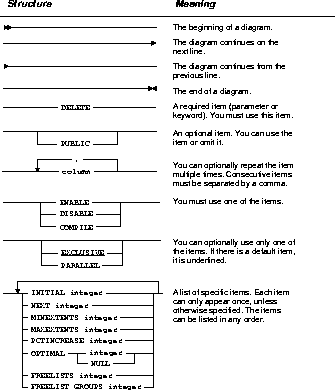| Oracle7 Server Tuning | Library |
Product |
Contents |
Index |
| Oracle7 Server Tuning | Library |
Product |
Contents |
Index |
This manual assumes you have already read Oracle7 Server Concepts, the Oracle7 Server Application Developer's Guide, and the Oracle7 Server Administrator's Guide.
For more information about Oracle Enterprise Manager and its optional applications, please see the following publications:
Oracle Enterprise Manager Concepts Guide
Oracle Enterprise Manager Administrator's Guide
Oracle Enterprise Manager Application Developer's Guide
Oracle Enterprise Manager: Introducing Oracle Expert
Oracle Enterprise Manager: Oracle Expert User's Guide
Oracle Enterprise Manager Performance Monitoring User's Guide. This manual describes how to use Oracle TopSessions, Oracle Monitor, and Oracle Tablespace Manager.
This chapter provides an overview of tuning issues. It defines performance tuning and the roles of individuals involved in the process.
Chapter 2: Performance Tuning Method
This chapter outlines the prioritized steps of the recommended tuning method, and explains how to apply the method.
Chapter 3: Diagnosing Performance Problems in an Existing System
This chapter provides an overview of performance factors in existing systems which have been properly designed.
Chapter 4: Overview of Diagnostic Tools
This chapter introduces the full range of diagnostic tools that are available for
This chapter describes the various types of application that use Oracle databases and the suggested approaches and features available when designing each.
Chapter 6: Designing Data Warehouse Applications
This chapter introduces integrated Oracle7 features for tuning enterprise scale
This chapter explains when to use the available optimization modes and how
Chapter 8: Data Access Methods
This chapter provides an overview of data access methods that can enhance performance, and warns of situations to avoid.
Chapter 9: Transaction Modes
This chapter describes the different methods in which read consistency is performed.
Chapter 10: Managing SQL and Shared PL/SQL Areas
This chapter explains the use of shared SQL to improve performance.
Chapter 11: Managing Partition Views
This section explains how to create and manage partition views, and provides an example of their use.
This chapter describes how to identify and solve problems with CPU resources.
Chapter 13: Tuning Memory Allocation
This chapter explains how to allocate memory to database structures. Proper sizing of these structures can greatly improve database performance.
Chapter 14: Tuning I/O
This chapter explains how to avoid I/O bottlenecks that could prevent Oracle from performing at its maximum potential.
Chapter 15: Tuning Networks
This chapter introduces networking issues which affect tuning, and points to the use of array interfaces, out-of-band breaks, and other techniques.
Chapter 16: Tuning Resource Contention
This chapter explains how to detect and reduce contention that may affect performance.
Chapter 17: Tuning the Operating System
This chapter explains how to tune the operating system for optimal performance of the Oracle Server.
Chapter 18: Parallel Query Tuning
The first half of this chapter outlines three basic parallel query tuning steps to get you up and running. The second half provides detailed information to help you diagnose and solve tuning problems.
This chapter describes views which are of the greatest use for both performance tuning and ad hoc investigation
Chapter 20: The EXPLAIN PLAN Command
This chapter shows how to use the SQL command EXPLAIN PLAN, and format its output.
Chapter 21: The SQL Trace Facility and TKPROF
This chapter describes the use of the SQL trace facility and TKPROF, two basic performance diagnostic tools which can help you monitor and tune applications that run against the Oracle Server.
Chapter 22: Oracle Trace Methodology
This chapter provides an overview of Oracle Trace usage and describes the Oracle Trace initialization parameters.
Chapter 23: Registering Applications
This chapter describes how to register an application with the database and retrieve statistics on each registered module or code segment.
This appendix discusses various optimization issues, to supplement "The Optimizer" chapter in Oracle7 Server Concepts.
Appendix B: SQL Processing Concepts
This appendix introduces the basics of SQL processing and outlines the general phases through which each SQL statement goes.
Appendix C: Parallel Query Concepts
This appendix describes the fundamentals of parallel query processing. It also describes how to parallelize SQL statements, set the degree of parallelism, and manage query servers.
For example, "If you create a private rollback segment, the name must be included in the ROLLBACK_SEGMENTS parameter of the parameter file."
This list shows parameters that appear in the syntax diagrams in this manual and examples of the values you might substitute for them in your statements:

INSERT INTO emp (empno, ename) VALUES (1000, 'SMITH');
ALTER TABLESPACE users ADD DATAFILE 'users2.ora' SIZE 50K;
Example statements may include punctuation, such as commas or quotation marks. All punctuation in example statements is required. All example statements terminate with a semicolon (;). Depending on the application, a semicolon or other terminator may or may not be required to end a statement.
Uppercase words in example statements indicate the keywords within Oracle SQL. When you issue statements, however, keywords are not case sensitive.
Lowercase words in example statements indicate words supplied only for the context of the example. For example, lowercase words may indicate the name of a table, column, or file.
Oracle7 Server Documentation Manager
|
Prev Next |
Copyright © 1996 Oracle Corporation. All Rights Reserved. |
Library |
Product |
Contents |
Index |